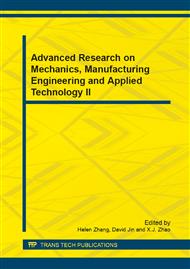p.385
p.390
p.394
p.399
p.403
p.407
p.411
p.416
p.423
Mechanical Research with Development of Automatic Handshaking Signal Module for Cross Connecting Cabinet Remote Monitoring Control
Abstract:
Since the urgent demands for high-speed broadband Internet, facilities originally installed in a unit-central office end are moved to the places close to the users in order to enhance the broadband and overcome the high-frequency attenuation of copper cables, such as cross connecting cabinets (CCC) on streets, and the lines between a unit-central office and CCC are changed to optical fiber cables. Network transmission technology has currently become the generation of optical fiber. To actually promote fiber to the home, the value-added services of high-speed Internet access, VoIP, and multimedia service for users are currently the highlighted telecommunications technology and businesses. Nevertheless, copper cables have been used for a long period of time that it would be costly to completely replace copper cables. Gradually replacing old cables with new ones is considered as the optimal strategy. Without constructing optical fiber lines at different places or completely removing copper cables, Automatic Handshaking Signal Module (AHSM) for a CCC developed in this study is considered economical and simple. It could monitor the signal handshaking through remote control and make structural and functional changes of existing copper-cable cross connecting cabinets for the low-cost and high-efficiency seamless technology transfer.
Info:
Periodical:
Pages:
403-406
Citation:
Online since:
April 2014
Authors:
Price:
Сopyright:
© 2014 Trans Tech Publications Ltd. All Rights Reserved
Share:
Citation:


